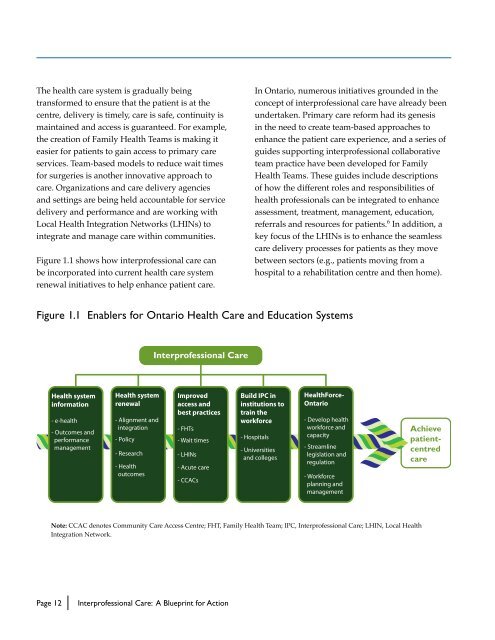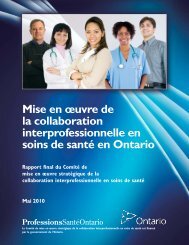Interprofessional Care: A Blueprint for Action - HealthForceOntario
Interprofessional Care: A Blueprint for Action - HealthForceOntario
Interprofessional Care: A Blueprint for Action - HealthForceOntario
You also want an ePaper? Increase the reach of your titles
YUMPU automatically turns print PDFs into web optimized ePapers that Google loves.
The health care system is gradually being<br />
trans<strong>for</strong>med to ensure that the patient is at the<br />
centre, delivery is timely, care is safe, continuity is<br />
maintained and access is guaranteed. For example,<br />
the creation of Family Health Teams is making it<br />
easier <strong>for</strong> patients to gain access to primary care<br />
services. Team-based models to reduce wait times<br />
<strong>for</strong> surgeries is another innovative approach to<br />
care. Organizations and care delivery agencies<br />
and settings are being held accountable <strong>for</strong> service<br />
delivery and per<strong>for</strong>mance and are working with<br />
Local Health Integration Networks (LHINs) to<br />
integrate and manage care within communities.<br />
Figure 1.1 shows how interprofessional care can<br />
be incorporated into current health care system<br />
renewal initiatives to help enhance patient care.<br />
Page 12 <strong>Interprofessional</strong> <strong>Care</strong>: A <strong>Blueprint</strong> <strong>for</strong> <strong>Action</strong><br />
In Ontario, numerous initiatives grounded in the<br />
concept of interprofessional care have already been<br />
undertaken. Primary care re<strong>for</strong>m had its genesis<br />
in the need to create team-based approaches to<br />
enhance the patient care experience, and a series of<br />
guides supporting interprofessional collaborative<br />
team practice have been developed <strong>for</strong> Family<br />
Health Teams. These guides include descriptions<br />
of how the different roles and responsibilities of<br />
health professionals can be integrated to enhance<br />
assessment, treatment, management, education,<br />
referrals and resources <strong>for</strong> patients. 6 In addition, a<br />
key focus of the LHINs is to enhance the seamless<br />
care delivery processes <strong>for</strong> patients as they move<br />
between sectors (e.g., patients moving from a<br />
hospital to a rehabilitation centre and then home).<br />
Figure 1.1 Enablers <strong>for</strong> Ontario Health <strong>Care</strong> and Education Systems<br />
Note: CCAC denotes Community <strong>Care</strong> Access Centre; FHT, Family Health Team; IPC, <strong>Interprofessional</strong> <strong>Care</strong>; LHIN, Local Health<br />
Integration Network.





